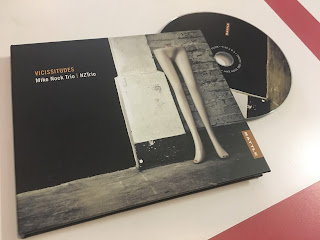Space Case - Retrospective (ALMA/CDMANU)
One of the things I like about
this series is that it will lead me to albums I may normally pass by. I can’t
say I’m much of a fusion fan, but if I skipped Space Case while undertaking
this listening project I would be missing out on a significant group comprised
of some the veterans of the New Zealand jazz scene - Murray McNabb (keyboards)
Frank Gibson Jr. (d/perc) Kim Paterson (trpt/flugel) Brian Smith (ts/ss) Bruce
Lynch (b). Andy Brown replaces Lynch after the first album. No doubt I will be encountering these names again (and again!) as the series continues. They weren't strangers to fusion - Brian Smith was a founding member of Ian Carr's group Nucleus, while Kim Paterson and Murray McNabb were part of the Frank Gibson Jr. led Dr. Tree (I plan to get to that eventually). Also, trumpeter Claudio
Roditi bassist Ron McClure appear on two tracks on the second album.
 This 2-disc set combines Space Case One (1981), Space Case Two (1983), and Space Case Three (1985). The fusion of
Space Case comes from the meeting of funk, latin, and jazz streams, with little
in the way of the rock. It’s quite a clean, slick sound rather than some of the
raw, exploratory examples from the beginnings of fusion. About half of the
tunes are by McNabb and Smith with the rest from the other members of the group
(although none from Paterson). The exception is the final track of the set -
Wayne Shorter’s “Delores.” Production aesthetics aside, some
of the tracks sound a bit dated ("Knight," "Funk City"), but I find this less of a problem on the more hardbop-esque
pieces (such as “Paratutu,” “Beaver Fever,” “J.C.A,” “Number Two” etc.). Hanging with the album this month
has caused a few of the tunes to stick in my mind and I‘ve caught myself
singing "Recurring Dream," "Brothers," "Southern Excursion" and "Number Two" on a number of occasions.
This 2-disc set combines Space Case One (1981), Space Case Two (1983), and Space Case Three (1985). The fusion of
Space Case comes from the meeting of funk, latin, and jazz streams, with little
in the way of the rock. It’s quite a clean, slick sound rather than some of the
raw, exploratory examples from the beginnings of fusion. About half of the
tunes are by McNabb and Smith with the rest from the other members of the group
(although none from Paterson). The exception is the final track of the set -
Wayne Shorter’s “Delores.” Production aesthetics aside, some
of the tracks sound a bit dated ("Knight," "Funk City"), but I find this less of a problem on the more hardbop-esque
pieces (such as “Paratutu,” “Beaver Fever,” “J.C.A,” “Number Two” etc.). Hanging with the album this month
has caused a few of the tunes to stick in my mind and I‘ve caught myself
singing "Recurring Dream," "Brothers," "Southern Excursion" and "Number Two" on a number of occasions.I may been displaying my saxophone bias, but initially I felt Brian Smith was the standout soloist (“Knight,” “Boat People,” “Paratutu”). His soprano tone is a bit nasal on the first album but it fills out later on, with the tone on "Beaver Fever" being a more pleasing to my tastes. The nasal quality is something I hear in many soprano tones from this period (and earlier in the 70s) - I'm not sure how much this was to do with conception, if it was a by-product of the recording process, or a combination of both.
Kim Paterson has some nice moments too - lyrical at times, more fiery at others. I particularly enjoyed his flugel playing in duo with Gibson on “Delores,” his fleetness on "Albert," and the fire on "Southern Excursion" (all from the final album). Side note: Brian Smith recorded the album Southern Excursion around that same time. I'm not sure if it has been reissued but I’ve added it to the list.
I had heard a bit about Murray McNabb but wasn't very familiar with his work. I found his playing as a soloist somewhat underwhelming, lacking the assertiveness of his bandmates. I dug his sneaky "Miles"/Milestones" quote during Paterson's solo on “Paratutu.” A few years later “Recurring Dream” would reappear on Song for the Dream Weaver, McNabb’s trio album with Ron McLure and Adam Nussbaum, and I'm interested to hear how he fares in that setting (I will get to it eventually).
Frank Gibson’s playing is creative, high energy and on the money throughout the set. It’s that busy approach common in fusion that I don’t really care for, but he does it really well. In fact, from an instrumental standpoint, Gibson is the dominant voice on these three albums. As this series progresses I will be hearing a lot more of the Gibson-Andy Brown pairing.
Although I had watched a video on youtube of Space Case performing on "Nock on Jazz," I was expecting things to be a bit more fusion-y than they ended up being. And while many jazz projects can be short lived or one-offs, it's nice to hear the same group (pretty much) develop over three albums. I would put down Space Case 1 as the most fusion-y. Space Case 2 straddles the first and third albums and in 1983 it was a finalist for jazz album of the year - they lost out to Rodger Fox (I'm currently compiling a list of the winners and finalists - stay tuned for more). Space Case 3 is less fusion-y than the previous two albums. Could this be a reflection of the "Young Lions" thing that was happening in the 80s with acoustic jazz becoming fashionable again?
It’s great that these albums have
been reissued but it would have been even better had they included facsimiles of the original
covers and notes too. Now someone needs to put together Fourth Way and
Sustenance retrospectives ASAP!




